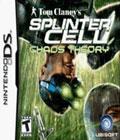Buy 'SPLINTER CELL: Chaos Theory':
Xbox | GameCube | PC | PlayStation 2
It’s official: the Splinter Cell series now has just as many releases under its belt as the franchise it is most often (wrongly) compared to, Metal Gear Solid. This fact should raise a few discerning eyebrows; MGS has been active since 1998, while Splinter Cell has a paltry three and a half years under its belt. These games are coming out pretty much yearly, putting them on the same level as Tony Hawk in that regard. Like Tony Hawk, each new release brings strong new ideas to the table, and presents them nicely, if not flawlessly. This type of release mostly satisfies the established fanbase, but does little to expand the audience. Chaos Theory should be no different.
The introduction of a fantastic co-op mode, along with further polish put towards the single player missions and the critically acclaimed multiplayer setup that began with Pandora Tomorrow, make Chaos Theory the best game in the series. The problem? It could have been better. Early talk around the time of the game’s announcement pointed to a revolutionized Splinter Cell experience; instead, we’re paying full price once again for what is essentially Super Pandora Tomorrow EX Plus Alpha. (Apologies to Capcom for that little jab there.) This is a great game – just as Super Street Fighter 2 Turbo was – but let’s face it: Super Turbo didn’t grab many new Street Fighter fans. It wasn’t captivating for any but those who could recognize the subtle nuances that made it the best fighting game of its time. Chaos Theory brings that same atmosphere to the table.
While we’re on the subject of atmosphere, let me tear into the single player game for a moment before singing its praises. Sam Fisher. Emotionless super-solider/freak. This is the third game in the series, and while this one is much more fleshed out in terms of story than Pandora Tomorrow, nobody could ever feel close to the lifeless meathead they play as. Well, an intelligent, incredibly skillful meathead, but a meathead nonetheless. The level of excitement is very strong throughout the game, of course, but none of it is connected to Sam in any way. When a game is this realistic, it would be nice to feel a little more investment in the character. This is typical Tom Clancy game stuff. Still, considering the surprising amount of life Clancy gives to his characters in his books, there is little excuse for the zombie-like super-soldiers that inhabit his videogame brand.
Less dull is the high-stress gameplay that the brand carries, especially in Splinter Cell. Rainbow Six and Ghost Recon are tense experiences in their own rights, but Splinter Cell – especially Pandora Tomorrow – is on a much higher level. The former games require quick thinking for survival. Splinter Cell requires both on-the-fly planning and meticulous strategizing, depending on the situation. To be successful in a game of Black Arrow, you need to fire the first shot. In a game of Chaos Theory, you need to make sure your enemy doesn’t get his finger anywhere near the trigger, and oftentimes not fire a weapon yourself in doing this. Yeah, Metal Gear Solid is tense, but not this tense where gameplay is concerned. Splinter Cell stands on its own in this regard.
Note that I cited Pandora Tomorrow as being the most tense experience out of the series. This is very true, but it is not a positive for that game. It introduced a graduated alert scale, one set up similarly to Metal Gear Solid 2 but in reverse. Instead of enemies calming down as the alert timer continues, Pandora’s alert meter rose as the threat continued. Enemies would find better equipment with each level, making the game astronomically harder if the player let poor Sam be found out. This system proved enjoyable for only the best players, and thankfully has been mostly eliminated in Chaos Theory. Instead, there are various grades of pre-alert; suspicion is noted, but not acted upon brashly. It serves as more of a warning, instead of throwing the player into a whirlwind of frantic action as Pandora Tomorrow did far too often.
Sam’s new arsenal, which revolves more around his default knife – which he just loves to brandish at every chance possible – than anything else, finally bringing this series to the place it needs to be in the stealth/action genre. The incredible arsenals from previous games were nearly useless temptors more than anything; now, with much less focus on them, and their presence somewhat diminished, the game is better for it. It’s strange to want less from a game, I know, but balance is the most important aspect of such a stress-driven game as this. I am thoroughly impressed by Ubisoft’s choices here. They have made the most balanced Splinter Cell yet. For the Xbox.
The PlayStation 2 version is a slightly different story. To compensate for the hardware, most of the 10 missions had to be cut considerably to conserve memory. The result is a much more compact environment, leaving both players and enemies with less space to contemplate when devising strategies. Of course the game still looks great, but I’m more of a substance-over-style kind of guy, and I would have taken downgraded lighting effects over shrunken geometry any day.
Pint-sized hallways aside, Chaos Theory is still a formidable release on the PlayStation 2, and it covers most of the additions seen by the Xbox version, of course ignoring any Live content that releases down the line. The most important is the new co-op mode, which is a completely separate experience from either the single player or team-based deathmatch modes. In it, players are forced to work as a team in order to complete missions. Team moves are executed always by pressing A, and range from giving a leg up to hanging onto your partner while he or she swings down to retrieve an item. The transition from the single player game to this mode is smooth, but the new stages are again dumbed down for the PlayStation 2 version, and from already shrunken environments in the original build, at that. While a fun diversion, this mode is not ready to take the place of the Rainbow Six meets Splinter Cell multiplayer classic that Pandora Tomorrow introduced. New modes have been added to this for Chaos Theory, but they all amount to pseudo-capture the flag... and somehow, that seems satisfying, because that’s the only mode this type of game needs. And there are only four new stages added, the other eight being ripped right out of Pandora Tomorrow... okay, so this mode is pretty much a re-tread of the previous game, but it is still the biggest draw here. Nevertheless, fans who played the original to death will definitely be irritated by this, and rightly so, once they pop in their new copy of Chaos Theory.
These constant, all-too-familiar moments that are spread throughout the game eventually converge to become its downfall. Hoping to discover more differences, I instead came away from Chaos Theory feeling sick, thanks to my stomach being full on stale, three-year-old Splinter Cell. The visual quality of this game was somewhat of a refresher – it didn’t make me dry-heave in the slightest, unlike Pandora Tomorrow with its identical graphics to its predecessor – but it still wasn’t the giant leap forward I was hoping for. And with the shrunken surroundings as the cost paid for the new pretty lighting and textures, well, I’m not sure if this is really what I wanted.
The sonic presentation did give me something a little different, for a change. Unexpectedly, the one element that usually stays the same from game to game, even years into a franchise, Chaos Theory has received not only a deluge of reworked sound effects, but the gameplay itself is much more sound-oriented than ever before. Two sound meters are presented on-screen, one measuring the amount of noise Fisher is producing, the other giving a constant readout of the ambient noise level. Both prove to be surprisingly useful, and bring both the gameplay and your surround sound setup to welcome levels of enjoyment.
And there you have it: the third Splinter Cell game in what has been announced to be a yearly affair. Each main release (Splinter Cell, and now Chaos Theory) will be followed by a more experimental affair (only Pandora Tomorrow thus far). Or so Ubisoft says. I found Chaos Theory to be much more experimental in nature, given the unbelievably stronger focus on stealth gameplay, made tangible by the sound meters and the knifeplay. Pandora Tomorrow added an irritating alert system and a multiplayer mode, which was huge, but it just became a part of the main series anyway. So what exactly do they mean by experimental? And how could the next game be only an incremental step forward from this one, when Chaos Theory, while impressive, is just another half-step forward? There aren’t any steps back, this time, but where is this series going to go? If anything, the Tony Hawk parallel I mentioned earlier will come to fruition with Splinter Cell. Let’s just hope the level of quality does not end up where that series is now. If Chaos Theory is any indication, there will be good times ahead – if you’re already a big fan of the series.
Score: 8.4/10
More articles about Splinter Cell Chaos Theory











 In Tom Clancy’s Splinter Cell Chaos Theory, the year is 2008. Citywide blackouts, stock exchange sabotage, electronic hijacking of national defense systems: This is information warfare. To prevent such attacks, operatives must infiltrate hostile territory and aggressively collect critical intelligence, getting closer than ever to enemy soldiers.
In Tom Clancy’s Splinter Cell Chaos Theory, the year is 2008. Citywide blackouts, stock exchange sabotage, electronic hijacking of national defense systems: This is information warfare. To prevent such attacks, operatives must infiltrate hostile territory and aggressively collect critical intelligence, getting closer than ever to enemy soldiers.






































